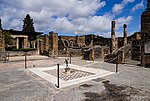Suburban Baths (Pompeii)

The Suburban Baths (Italian Terme Suburbane) are a building in Pompeii, Italy, a town in the Italian region of Campania that was buried by the eruption of Mount Vesuvius in 79 AD, which consequently preserved it.The Suburban Baths were publicly owned, as were also the Stabian, Forum, and Central baths in the city. They were built in the early empire, possibly under the Emperor Tiberius (14–37 AD), much later than the others and thus were built outside the city walls near the Porta Marina, one of the city gates. By this time, land was more easily available outside the city as the walls had lost their defensive role after the town became a Roman colony.The baths also benefitted from the increased supply of running water after the connection of the city to the Aqua Augusta aqueduct in 30–20 BC.The bathhouse was renovated after the earthquake of 62 AD, when a piscina calida, a heated swimming pool, was added to the north of the complex.The baths were discovered in 1958, much later than the rest of the city, though a systematic excavation had to wait until 1985–1987.Although publicly owned, these baths seem to have been reserved for a private clientele unlike the other public baths.The building is notable for its surviving erotic wall paintings, the only set of such art found in a public Roman bath house.
Excerpt from the Wikipedia article Suburban Baths (Pompeii) (License: CC BY-SA 3.0, Authors, Images).Suburban Baths (Pompeii)
Via Consolare,
Geographical coordinates (GPS) Address Nearby Places Show on map
Geographical coordinates (GPS)
| Latitude | Longitude |
|---|---|
| N 40.748611111111 ° | E 14.482777777778 ° |
Address
Regio VII
Via Consolare
80045
Campania, Italy
Open on Google Maps











